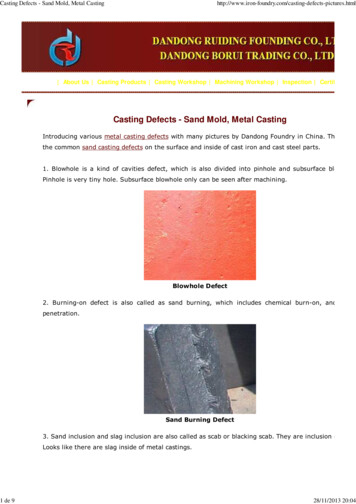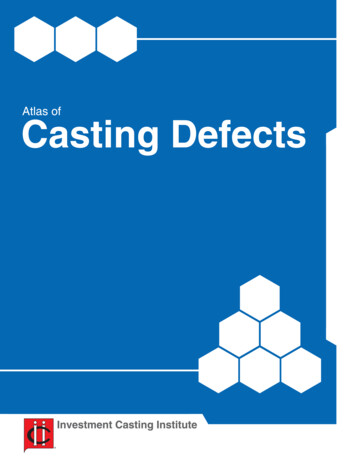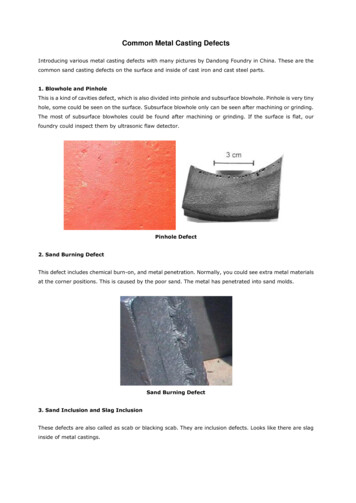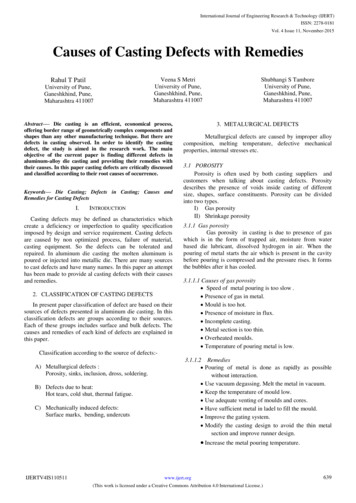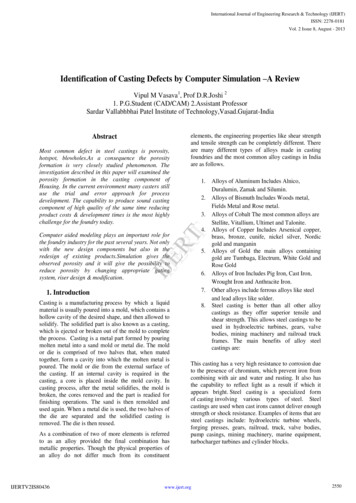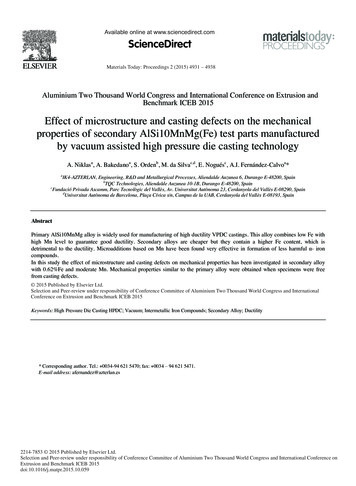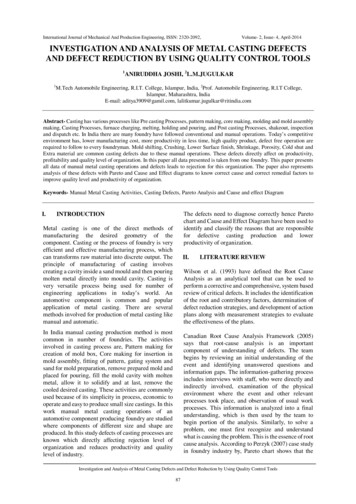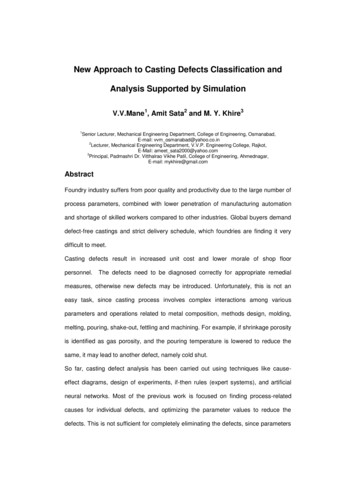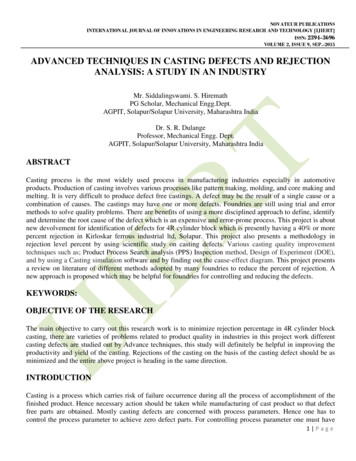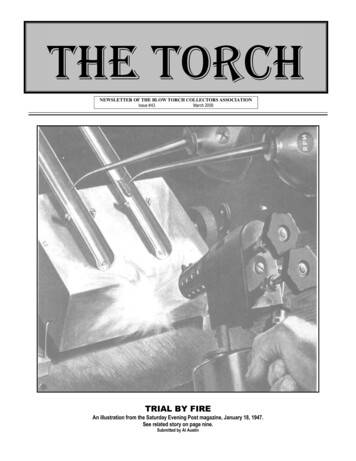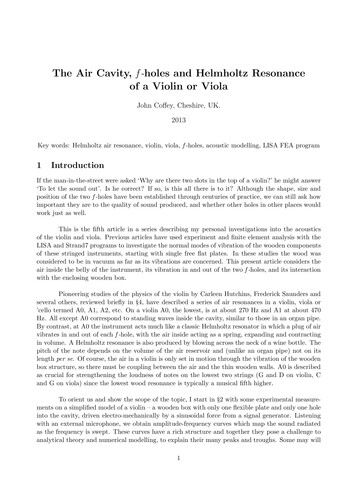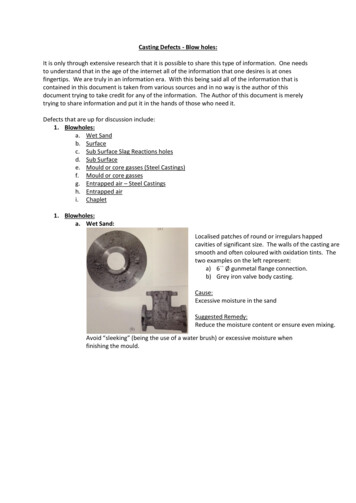
Transcription
Casting Defects - Blow holes:It is only through extensive research that it is possible to share this type of information. One needsto understand that in the age of the internet all of the information that one desires is at onesfingertips. We are truly in an information era. With this being said all of the information that iscontained in this document is taken from various sources and in no way is the author of thisdocument trying to take credit for any of the information. The Author of this document is merelytrying to share information and put it in the hands of those who need it.Defects that are up for discussion include:1. Blowholes:a. Wet Sandb. Surfacec. Sub Surface Slag Reactions holesd. Sub Surfacee. Mould or core gasses (Steel Castings)f. Mould or core gassesg. Entrapped air – Steel Castingsh. Entrapped airi. Chaplet1. Blowholes:a. Wet Sand:Localised patches of round or irregulars happedcavities of significant size. The walls of the casting aresmooth and often coloured with oxidation tints. Thetwo examples on the left represent:a) 6 Ø gunmetal flange connection.b) Grey iron valve body casting.Cause:Excessive moisture in the sandSuggested Remedy:Reduce the moisture content or ensure even mixing.Avoid “sleeking” (being the use of a water brush) or excessive moisture whenfinishing the mould.
b. Surface:This defect is characterised by localized areas of small cavities or pits on the surfaceof a casting. The example given below shows defects located on the inner diameter(the core side) of a small Phosphor-bronze casting containing 10%Sn, 0.3% P:Possible Cause:Local overheating of the mould or core surfacesSuggested Remedy:Avoid local overheating of mould or core sand by the utilization ofproper running methods. (Illustrations below show good runningmethod bottom with the top one being a bad running method). Use ofgood refractory dressing. Check the pouring temperature.Localized areas of small cavities/pits on the surface ofthe casting. The picture on the left shows defects onthe flange of a 4 bore branch pipe in Ni-Cr Iron alloycast in dry sand. This defect usually occurs on heaviersections of castings which solidify at a slower ratethan the thinner sections. Rule of thumb suggeststhat it is most commonly experience on castings ½ and over. Stainless and other high alloyed steels aresusceptible to this defect.Possible Cause:Reactions between the molten metal and the water vapour in the mould or moulddressing is the most likely culprit contributing to this type of defect.Suggested Remedy:Use a mould dressing that will not evolve water vapour when heated. Moulddressings bonded with such materials such as ethyl silicate provide satisfactory
results. Defects may also be minimized by the use of permeable well dried mouldsmade from either oil bonded sand or synthetic sand containing a minimum amountof clay bond. Avoid local overheating of the mould or core sand by proper methodsof running.The above picture is a. enlargement of the above picture of which the areaexpressed is indicated by the arrow.c. Sub Surface Slag Reactions holes:This type of blow hole is unique inappearance as it consists of small holes withrounded or irregular shapes which may attimes contain shot/grit at or just below thecasting surface. These blowholes mainlyoccur particularly on top surfaces and belowcores. They may be revealed on cleaning orafter machining. These holes havediscoloured surfaces which are oftenassociated with slag inclusions and sandgrains.Possible Cause:Fluid containing slag and manganese oxides entering the mould could react with themetal. High manganese content and high sulphur contents coupled with lowpouring temperatures favour this kind of defect.Suggested Remedy:Avoid very fluid slags formed by oxidation of the metal in the ladle, or coming fromlow melting point refractories such as botting clays. Skim the metal thoroughly, usestrainer cores, slag traps and good gating practices. Keep the runners full of metal.Reduce the manganese content to a level just adequate to balance the sulphurcontent (Mn 1.7 x S% 0.3), reduce the sulphur content and raise the pouringtemperature.
d. Sub Surface:Small cavities adjacent to the surface of the casting (and usually on all surfaces ofthe casting). In many cases the surface of the casting appears to be normal (whichmakes this a difficult defect to identify in the as cast condition. In some caseshowever, surface pitting may be present as illustrated below:Possible Cause:This type of defect is caused by a reaction of the molten metal with the moisture inthe moulding sand. This is mostly associated (but not always) with high pouringtemperatures and is encouraged by insufficient de-oxidation, insufficientpermeability in the sand and insufficient ventilationSuggested Remedy:Reduce the volatile contend in the mould cores and dressing. Ensure that thematerial is sufficiently de-oxidized. Increase the level of ventilation and increase thepermeability of the sand. Reduce the pouring temperature if possible.e. Mould or core gasses (Steel Castings)Round shaped holes with bright smooth wallswhich normally present themselves once thecasting is sectioned as shown above. In somecases where blowholes has appeared fromconcentrated pellets of other materials such asclay in the mould, the defect may migrate to thesurface of the casting.Possible Causes:Significant/excessive evolution of gases from themould or core sand together with lowpermeability and insufficient venting of themould or core. It may also be the result ofimproperly mixed mould and core sand.
Suggested Remedy:Make sure that the sand is properly mixed and milled and that the materials (i.e.bonding) are dispersed uniformly throughout the mix. Ensure that the cores are dryand properly baked. Make use of less organic binders or additions and increase thepermeability/ventilation of the sand/mould.f.Mould or core gassesThis defect appears with smooth walls and a round orientation. The source of theissue is often difficult to identify unless the casting is sectioned. The picture below isa 100mm Ø grey cast pulley wheel casting showing blowholes from the core.Possible Cause:Excessive gas build up from the moulding orcore sand coupled with insufficientpermeability or venting. Mat also be a resultof metal entering the core vents.Suggested remedy:Use less oil binder. Ensure that the cores aresufficiently dry and properly baked. Increasethe permeability of the sand and ensure thatthe mould and cores are properly vented.Ensure that the sand is properly mixed andfree of local contractions of core binder, coaldust, etcg. Entrapped air – Steel Castings:These blowholes appear to be round with smooth out walls found on or just underthe surface of the castingBoth of the pictures (a) and (b) are small castingswith wall thicknesses ranging from 6 – 19mm incross section. Both items were cast in green sand.Possible Cause:Entrapped airSuggested Remedy:Increase the permeability of the sand as well as theventing of the mould. Try and avoid fast andturbulent metal flow into the mould.
h. Entrapped air:Elongated cavities of appreciable size consisting of smooth walls located on or justbelow the surface of the casting located near the highest part of the castcomponent.Possible Cause:Entrapped airSuggested Remedy:Make use of a vent in the affected area. Wiremay be used to increase the permeability ofthe sand should the surface finish of theproduct allow for it. Check the degree oframming or mould hardness at the affectedareas.i.Chaplet:Smooth-walled cavities adjacent to Chaplets which are round or elongated inappearance. This defect is more often than not associated with issues associated tothe fusion of the chaplet with the casting and may cause leakage when exposed topressure.Picture (a) and (b) show blowholes and imperfect fusion of the chaplet in a grey castiron. (c) shows good fusion of chaplet with metal.Possible Causes:Rusty, Dirty, Damp or improperly coated ChapletsSuggested Remedy:Make sure that the Chaplets are clean, dry and freeof contamination. Bright iron steel chaplets aredeemed to be satisfactory when used immediately.However they may cause blowing if allowed tostand in the mould (long enough for rust todevelop. The use of Tin-coated or Copper coatedchaplets is recommended to avoid this issue. Zincor alloys containing Zinc are problematic forchaplets as they will also cause “blowing”Reference materials:Atlas of Defects in Castings – Institure of Brittish FoundrymenVarious Internet sources
Casting Defects - Blow holes: It is only through extensive research that it is possible to share this type of information. One needs to understand that in the age of the internet all of the information that one desires is at ones fingertips. We are truly in an information era. With this being said all of the information that is contained in this document is taken from various sources and in no .File Size: 498KBPage Count: 6
